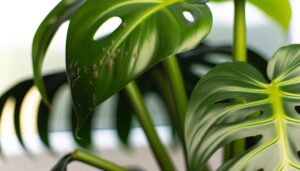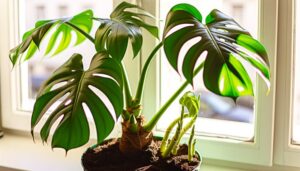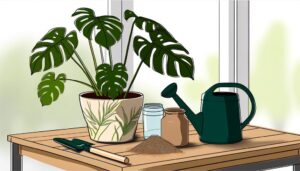How to Care for Monstera Albo Cutting? A Step-by-Step Guide!
To care for a Monstera albo cutting, start by selecting a healthy cutting with at least one node and visible aerial roots. Slice diagonally below the node using sanitized tools.
For rooting, place the cutting in water in a transparent container, ensuring nodes are submerged and changing water regularly. Alternatively, use well-draining soil composed of peat moss, perlite, and orchid bark.
Provide bright, indirect sunlight at 10,000 to 20,000 lux and maintain 60-80% humidity with a humidifier. Regularly inspect for pests and manage infestations with horticultural oil.
Proper care will lead to successful propagation and robust growth. Discover more details on advancing your plant’s health.
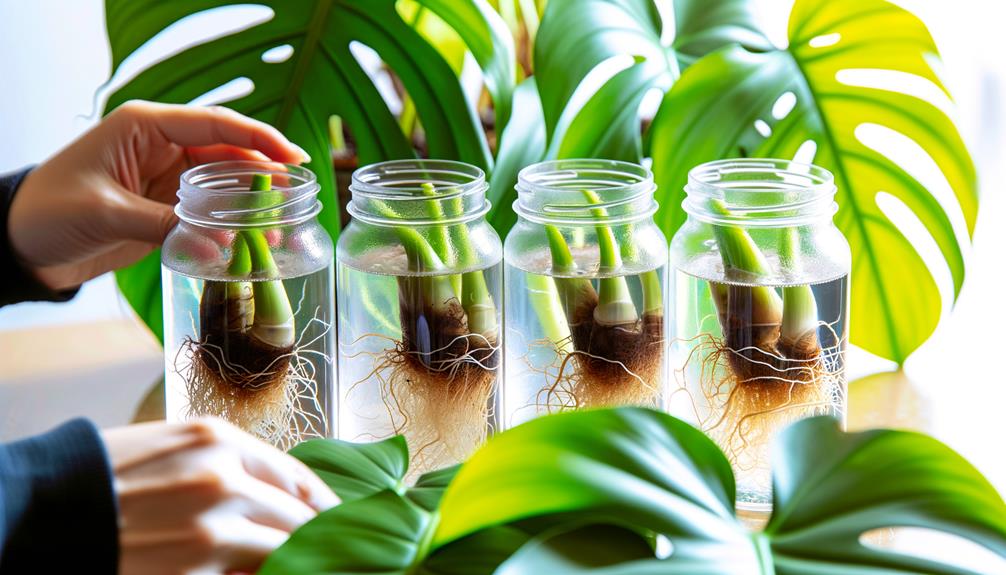
Key Takeaways
- Ensure the cutting has at least one node and healthy aerial roots.
- Provide bright, indirect sunlight with 10,000-20,000 lux intensity.
- Root in water or well-aerated soil, maintaining consistent moisture.
- Maintain 60-80% humidity using a tray and pebbles or a humidifier.
- Regularly inspect for pests and treat minor infestations with horticultural oil or soap.
Selecting a Healthy Cutting
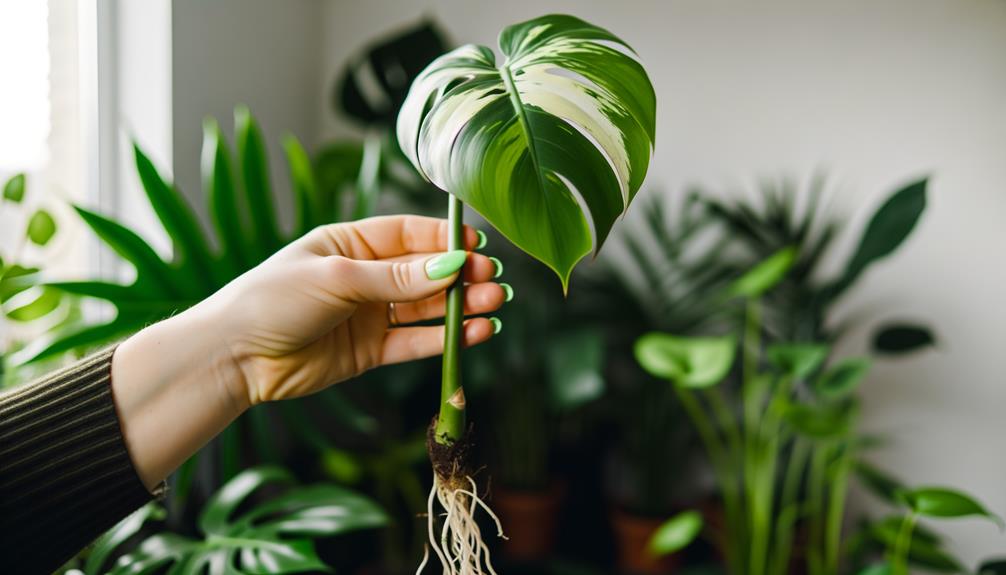
To select a healthy Monstera Albo cutting, make sure the cutting has at least one node and a few aerial roots visible. The node is a critical anatomical structure, as it contains meristematic tissues essential for root initiation and growth.
Inspect the cutting for variegation; consistent white and green patterns indicate genetic stability. Avoid cuttings with excessive browning or yellowing, as these may signify underlying health issues.
Examine the aerial roots closely; robust, firm roots suggest a healthy cutting capable of nutrient absorption. Confirm the stem is firm and free from soft, mushy spots that indicate rot.
Preparing the Cutting
Begin by sterilizing your pruning shears or a sharp knife with rubbing alcohol to prevent any potential contamination and infection in the Monstera Albo cutting.
Next, identify a node where the leaf joins the stem; this is crucial for successful propagation.
Make a clean, diagonal cut just below the node, maximizing the cutting has at least one healthy leaf and aerial root.
Remove any excess leaves to reduce transpiration stress.
Key steps to remember:
- Sanitize your tools to prevent disease.
- Locate a node for best rooting.
- Slice diagonally below the node.
- Guarantee the cutting has a leaf and aerial root.
- Eliminate excess leaves to minimize water loss.
These steps optimize your cutting is primed for successful propagation.
Rooting in Water
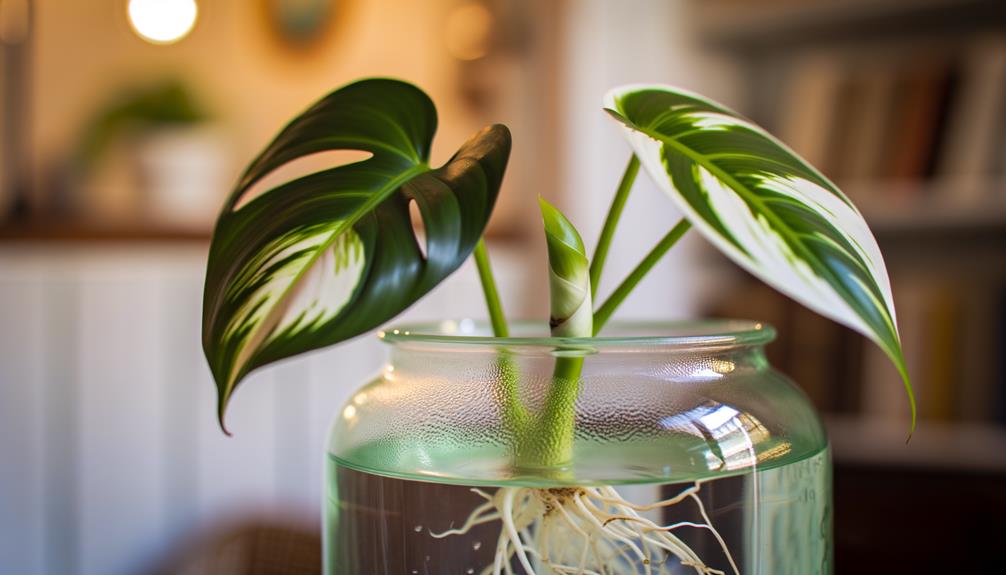
To optimize root development, select a transparent container to allow for light penetration and easy observation.
Guarantee you monitor the root growth closely, looking for signs of healthy, white roots emerging.
Change the water regularly to prevent bacterial buildup and support oxygenation.
Choosing the Container
Selecting a see-through receptacle with a slim opening will help support the Monstera Albo cutting while optimizing root development visibility. Choose a glass vessel to allow light penetration, which can facilitate photosynthesis in submerged roots.
The slim opening stabilizes the cutting, preventing it from tipping over. Confirm the container is spotless to avoid bacterial contamination. Fill it with dechlorinated water to maintain a sterile environment.
Consider the following when selecting your container:
- Transparency: Enhances visibility for monitoring root growth.
- Slim Opening: Provides structural support to the cutting.
- Glass Material: Promotes light penetration and cleanliness.
- Size: Accommodates the cutting without overcrowding.
- Cleanliness: Prevents pathogenic bacterial growth.
Monitoring Root Growth
After placing your Monstera Albo cutting into the chosen container, closely observe the root development to guarantee ideal growth conditions. Monitor the cutting daily, ensuring the water level remains constant, covering the nodes where roots emerge.
Replace the water every 3-5 days to prevent bacterial growth, which can impede root development. Inspect the water for cloudiness and any signs of rot. Healthy roots should appear white or light tan and exhibit steady elongation.
If roots turn brown or mushy, trim the affected areas with sterilized scissors to prevent further decay. Maintain a temperature range of 65-75°F (18-24°C) and provide indirect sunlight to optimize root growth.
Rooting in Soil
When rooting your Monstera Albo cutting in soil, select a well-aerated, nutrient-rich soil mix to promote healthy root development.
Guarantee the pot has proper drainage to prevent waterlogging and root rot.
Maintain ideal moisture by keeping the soil consistently damp but not saturated, monitoring it regularly.
Choose Suitable Soil Mix
A well-draining soil mix, rich in organic matter and perlite, is vital for successfully rooting your Monstera Albo cutting. To create an ideal environment, start by combining equal parts peat moss, perlite, and orchid bark. This blend ensures proper aeration and moisture retention, necessary for root development.
Ensure the soil mix includes:
- Peat moss: Enhances moisture retention and provides organic matter.
- Perlite: Promotes aeration and prevents soil compaction.
- Orchid bark: Improves drainage and simulates natural epiphytic conditions.
- Activated charcoal: Absorbs toxins and minimizes root rot risk.
- Compost: Supplies essential nutrients and boosts microbial activity.
Mix these components thoroughly to achieve a balanced substrate. This combination supports healthy root growth by maintaining optimal moisture levels and preventing waterlogging.
Ensure Proper Drainage
Proper drainage is crucial to prevent waterlogged conditions that could lead to root rot in your Monstera Albo cutting. Begin by selecting a pot with ample drainage holes to facilitate water egress.
Utilize a well-aerated, fast-draining soil mix incorporating perlite, bark, and peat moss. When planting, position the cutting such that the node is slightly above the soil surface, ensuring it doesn’t submerge completely.
Monitor the water flow during irrigation; water should percolate quickly through the substrate without pooling. You can add a layer of coarse gravel or activated charcoal at the pot’s base to enhance drainage further.
These measures help maintain an efficient balance of moisture and air, fostering a robust root development environment.
Maintain Optimal Moisture
To sustain peak moisture levels for your Monstera Albo cutting, consistently monitor soil dampness using a moisture meter and make certain the substrate remains moist but not waterlogged. This equilibrium is crucial for root development and overall plant health. Utilize a well-aerated soil mix to facilitate prime moisture retention and drainage.
- Check soil dampness: Insert the moisture meter to a depth of about 2-3 inches.
- Watering schedule: Water when the meter reads ‘moist’ rather than ‘wet’ or ‘dry’.
- Container drainage: Confirm the pot has adequate drainage holes to prevent water accumulation.
- Ambient humidity: Maintain room humidity around 60-70% to support soil dampness.
- Soil composition: Use a mix containing perlite or orchid bark to enhance aeration and moisture control.
Maintaining these parameters guarantees robust root growth and plant vigor.
Ideal Light Conditions

Place your Monstera Albo cutting in an area where it can receive bright, indirect sunlight for optimal growth and variegation. Confirm the light source provides approximately 10,000 to 20,000 lux, mimicking dappled sunlight conditions.
Avoid direct sunlight, as it may cause photodamage, resulting in chlorosis or necrosis of the leaves. Utilize a light meter to measure intensity and adjust placement accordingly. If natural light is inadequate, consider using full-spectrum grow lights with a color temperature of 5000K to 6500K.
Maintain a photoperiod of 12-14 hours per day to support photosynthesis and metabolic activity. Regularly rotate the cutting to guarantee even light distribution and prevent etiolation, which can lead to weak, elongated growth.
Watering Requirements
While maintaining ideal light conditions, it’s equally important to monitor the moisture levels in the growing medium for your Monstera Albo cutting. Consistent hydration is essential for root development and overall plant health.
Water the cutting when the top inch of the substrate feels dry. Utilize a well-draining potting mix to prevent waterlogging, which can lead to root rot.
- Check soil moisture: Insert your finger about an inch into the soil.
- Watering frequency: Generally, once a week, but adjust based on environmental conditions.
- Water quality: Use distilled or rainwater to avoid mineral buildup.
- Drainage: Ensure the pot has drainage holes to allow excess water to escape.
- Even moisture: Water evenly around the base of the cutting to promote uniform root growth.
Accurately following these instructions will help your Monstera Albo cutting thrive.
Maintaining Humidity
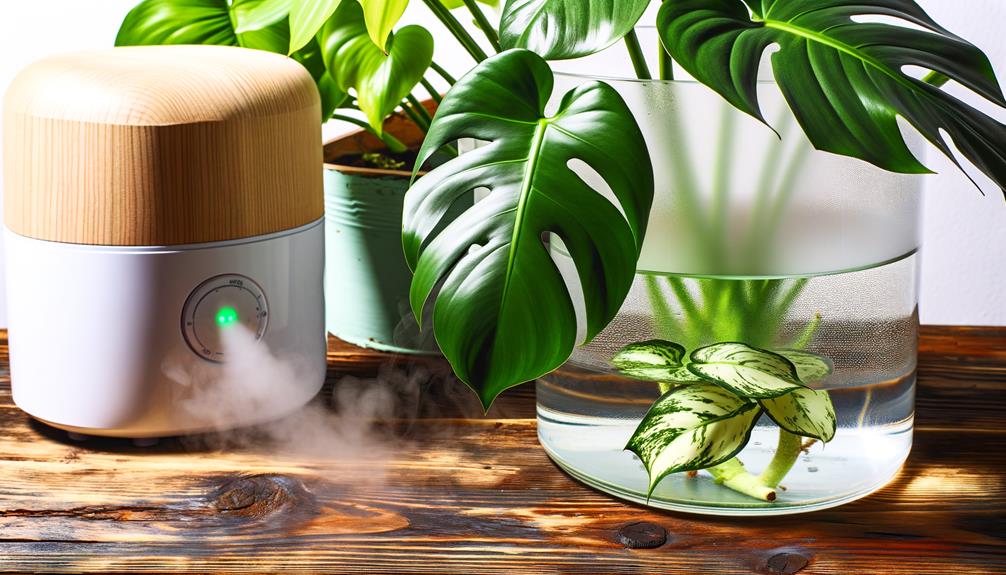
Maintaining ideal humidity levels is crucial for the successful growth and health of your Monstera Albo cutting. Aim for a relative humidity of 60-80%. Utilize a hygrometer to monitor levels accurately.
If humidity is low, employ a humidifier or create a microenvironment by placing a clear plastic bag over the cutting, ensuring it doesn’t touch the leaves. Misting the foliage can help, but avoid excessive moisture, which can promote fungal growth.
Place the cutting on a tray filled with water and pebbles to increase ambient humidity through evaporation. Keep the cutting away from drafts and air conditioning vents, which can reduce humidity.
Regularly check and adjust to maintain the best conditions for vigorous growth.
Monitoring for Pests
Regularly check your Monstera Albo cutting for common pests like spider mites, aphids, and scale insects to guarantee early detection and effective management.
Use a magnifying glass to identify minuscule pests. Look for signs such as yellowing leaves, stippling, or a sticky residue known as honeydew. Employ horticultural oil or insecticidal soap to treat minor infestations. For severe cases, consider systemic insecticides.
To help with thorough monitoring:
- Examine leaf undersides: Pests often conceal here.
- Check new growth: Susceptible to infestations.
- Inspect soil surface: Pests can inhabit the substrate.
- Monitor humidity: Elevated humidity can deter spider mites.
- Regularly clean leaves: Decreases pest habitat.
Effective pest control safeguards the health and vigor of your Monstera Albo cutting.
Conclusion
Caring for your Monstera Albo cutting demands care and accuracy. By choosing a healthy cutting, preparing it correctly, and selecting the right medium—whether water or soil—you guarantee prime rooting.
Perfect light conditions, consistent watering, and maintaining high humidity levels are essential. Diligently monitor for pests to avoid infestations.
Following these detailed steps will increase your chances of success, showing that careful attention greatly improves the growth and health of Monstera Albo cuttings.

